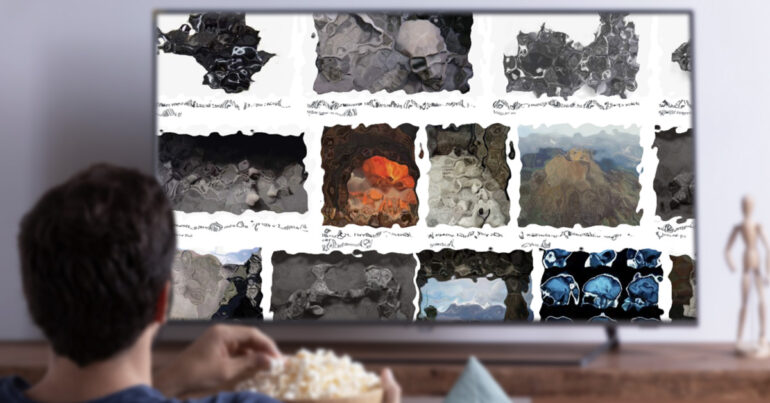

September 23, 2022
Exhibition opening: September 23rd from 6 pm
Exhibition duration: September 23rd – November 2nd, 2022.
Guided tour with translation into PJM October 8th, 14:00
curator: Martyna Stołpiec
“The future is dark, which is the best thing the future can be, I think.”
Rebecca Solnit, citing a quote by Virginia Wolf in her essay ” Woolf’s Darkness: Embracing the Inexplicable” points out the potential of a dark vision of the future. She sees remaining in uncertainty and moving beyond known boundaries as ways of exploring the unconscious. This quote is from 1915 – the beginning of the First World War. The resounding sense of sadness, anxiety and overwhelm still accompanies us today. Perhaps it is a human reflex to delude ourselves that everything will somehow work out. However, lack of direction, confusion and openness to the unknown can lead to surprising discoveries. If lingering in the dark were considered a method, the work on this exhibition would be its realization.
The artist uses familiar aesthetic codes: beige walls, printed carpets and glass decorations. The darkness that shrouds the exhibition is therefore not monstrous. On the contrary, it appears tame and invites you to make yourself at home. The title of the exhibition refers to numerous online articles appearing over the past few years. According to researchers, some of the brains of the victims of the catastrophe caused by the eruption of Vesuvius have turned into glass. Alder, like flowing lava, transforms volatile into solid. Hard-to-grasp sensations solidify and become “amazing” objects, more “glass brains.” They will not shine with their own light, but they will probably help focus or reflect the tiniest flares. Perhaps it is thanks to them that we will be able to see new ways in the darkness.
UA
Домініка Ольшови | Мозок жертви перетворився на скло від виверження Везувію
Відкриття виставки: 23 вересня від 18:00
Тривалість виставки: 23 вересня – 2 листопада 2022 року
Екскурсія з оригіналу в PJM 8 жовтня о 14:00.
куратор: Мартина Столпєц
«Майбутнє виглядає темним, що, на мою думку, є найкращою перспективою для майбутнього».
Ребекка Солніт, посилаючись на цитату Вірджинії Вулф у есею «Темрява Вірджинії: прийміть те, чого ви не можете пояснити», звертає увагу на потенціал темного бачення майбутнього. Перебування в невизначеності та зображення поза межами бачить як способи дослідження того, чого не усвідомлює. Ця цитата походить з 1915 року – початку Першої світової війни. Почуття смутку, тривоги та непереборності, яке резонує в ній, також супроводжує нас сьогодні. Можливо, це людський інстинкт вірити, що все буде добре. Однак відсутність орієнтиру, заблукання та відкриття невідомому можуть призвести до дивовижних відкриттів. Якби ми розгядали перебування в темряві як метод, робота над цією виставкою була б її реалізацією.
Мисткиня, однак, використовує відомі естетичні коди: бежеві стіни, килими з принтами та скляні декорації. Тому темрява, яка оточує виставку, не є страшною. Навпаки, виглядає звиклою та підштовхує почутися як вдома. Назва виставки відсилає до численних статей в інтернеті, які з’явилися за останні декілька років. За словами дослідників, деякі мізки жертв катастрофи викликаної виверженням Везувію перетворилися на скло. Ольшови, як текуча лава, перетворює литкі речовини на тверді. Важкі почуття тверднуть і стають «дивовижними» предметами, іншими «скляними мізками». Вони не будуть світитись особистим світлом, але, ймовірно, допоможуть зосередити або відобразити найдрібніші спалахи.Можливо, саме завдяки їм ми бачимо нові дороги в темряві.